|
|
 |
|
Cyclopoida ( Order ) |
|
|
|
Oithonidae ( Family ) |
|
|
|
Dioithona ( Genus ) |
|
|
| |
Dioithona rigida (Giesbrecht, 1896) (F,M) | |
| | | | | | | Syn.: | Oithona rigida Giesbrecht, 1896 (1897) (p.324, Descr.F, figs.F); Zhang G.-T. & Wong, 2011 (p.277, fig.8, indicator);
Dioithona alia Kiefer, 1935 f (p.323); Wellershaus, 1970 (p.473, 481); Noda & al., 1998 (p.55, Table 3, occurrence);
? Dioithona aurea Lindberg, 1947;
Dioithona rigida aurea Lindberg, 1950 e (p.265, figs.F,M);
Dioithona rigida elongata Lindberg, 1950 e (p.268, figs.F,M);
Oithona (Dioithona) rigida : Kos, 1972 (Vol.I, figs.F, Rem.); Shuvalov, 1980 (p.177, figs.juv.,F,M);
Oithona rigida : Thompson & Scott, 1903 (p.236, 255); Wolfenden, 1905 (1906) (p.1023, fig.F); A. Scott, 1909 (p.194, Rem.); Rosendorn, 1917 a (p.39, Rem. F); Früchtl, 1924 b (p.70); Kiefer, 1929 g (p.10, Rem.F); Farran, 1936 a (p.124); Mori, 1937 (1964) (p.113, figs.F,M); Sewell, 1947 (p.256, Rem.F); Krishnaswamy, 1953 (p.65, Rem.); Rao, 1958 (p.128, figs.juv.); Yamazi, 1958 (p.153, Rem.); Kasturirangan, 1963 (p.76, 77, figs.F); Saraswathy, 1966 (1967) (p.89); Wellershaus, 1970 (p.469, 480, figs.F,M); Goswami & Goswami, 1972, p.154, fig.); Chen & al., 1974 (p.35, figs.F,M, p.74: Rem.); Nishida, 1985 a (p.72, 76, figs.F, Rem., p.143, 144); Sazhina, 1985 (p.90, figs. N); Kim & al., 1993 (p.271); Chihara & Murano, 1997 (p.938, Pl.197, 202: F,M); Bradford-Grieve & al., 1999 (p.886, 966, figs.F,M); McKinnon, 2000 (p.108, Rem.); Santhanam & Perumal, 2013 (p.236, Descr. developmental stages N, C1-C6, figs. N-C6);
Ref. compl : Cleve, 1904 a (p.193); Gurney, 1927 (p.160, Rem.); Ganapati & Shanthakumari, 1962 (p.10, 16); De Decker, 1964 (p.16, 23, 27); De Decker & Mombeck, 1964 (p.13); Subbaraju & Krishnamurphy, 1972 (p.25, 26 ); Chen Q-c, 1980 (p.795); Kimmerer & McKinnon, 1985 (p.150); Othman & al., 1990 (p.561, 564, Table 1); Yoo, 1991 (tab.1); McKinnon, 1991 (p.471); Yoo & Lim, 1993 (p.91, Rem.: p.95, Table 1); Godhantaraman, 1994 (tab.5, 6, 7); Shih & Young, 1995 (p.75); Gouda & Panigrahy, 1995 (p.206); Park & Choi, 1997 (Appendix); Suarez-Morales & Gasca, 1998 a (p.112); Ueda al., 2000 (tab.1); Dalal & Goswami, 2001 (p.23, tab.2); McKinnon & al., 2003 (p.101, tab.2, fig.11); Rezai & al., 2004 (p.486, tab.2, 3, abundance); Lan & al., 2004 (p.332, tab.1); Lo & al., 2004 (p.89, tab.1); Hwang al., 2005 (p.106); Hwang & al., 2006 (p.943, tabl. I); Lopez-Ibarra & Palomares-Garcia, 2006 (p.63, Tabl. 1, seasonal abundance vs El-Niño, Rem.: p.69, 72, ); McKinnon & al., 2008 (p.851: fig.7); Tseng L.-C. & al., 2008 (p.153, fig.5, Table 2, occurrence vs geographic distribution, indicator species); Ohtsuka & al., 2008 (p.115, Table 5); C.-Y. Lee & al., 2009 (p.151, Tab.2); Hwang J.-S. & al., 2010 (p.220, Table 2, fig.3, 4, %, abundance); Hernandez-Trujillo & al., 2010 (p.913, Table 2); Fazeli & al., 2010 (p.153, Table 1); Maiphae & Sa-ardrit, 2011 (p.641, Table 2); Hsiao & al., 2011 (p.317, Table 2, indicator of seasonal change); Tseng L.-C. & al., 2011 (p.239, Table 3, abundance %); DiBacco & al., 2012 (p.483, Table S1, ballast water transport); Johan & al., 2012 (2013) (p.1, Table 1); Santhanam & Perumal, 2012 (p.369, feeding, egg production, hatching rate, growth vs. enviromental factors); 2012 a (p.38, feeding, egg production); Palomares-Garcia & al., 2013 (p.1009, Table I, abundance vs. environmental factors); in CalCOFI regional list (MDO, Nov. 2013; M. Ohman, comm. pers.); Jagadeesan & al., 2013 (p.27, Table 3, seasonal variation); Mendoza Portillo, 2013 (p.37: Fig.7, seasonal dominance); Palomares-Garcia & al., 2018 (p.178, Table 1: occurrence) | | | | Ref.: | | | Böttger-Schnack, 1995 (p.92); Boxshall & Halsey, 2004 (p.611) | 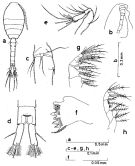 Issued from : S. Nishida in Bull. Ocean Res. Inst., Univ. Tokyo, 1985, No 20. [p.77, Fig.42]. As Oithona rigida. Female (from Bay of Umm: Persian Gulf): a, habitus (dorsal); b, forehead (lateral); c, thoracic segment 5 and genital segment (lateral left side); d, anal segment and caudal rami (dorsal); e, A2; f, Md (biting edge); g, Mx2; h, Mxp. Nota: Proportional lengths of urosome segments and caudal ramus 13:29:15:14:13:16.
|
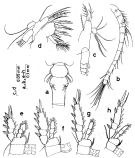 Issued from : S. Nishida in Bull. Ocean Res. Inst., Univ. Tokyo, 1985, No 20. [p.78, Fig.43]. As Oithona rigida. Female: a, last thoracic segments and genital segment (dorsal); b, A1; c, Md (mandibular palp); d, Mx1; e, P1; f, P2; g, P3; h, P4.
|
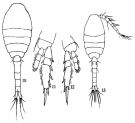 issued from : Q.-c Chen & S.-z. Zhang & C.-s. Zhu in Studia Marina Sinica, 1974, 9. [Pl.3, Figs.10-13]. As Oithona rigida. Female (from China Seas): 10, habitus (dorsal); 11, P3; 12, P4. Nota: 4 inner setae on exopod 3 of P1 instead of 5 as given by Rosendorn (1917). Male: 13, habitus (dorsal).
|
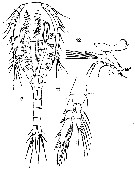 issued from : T. Mori in The Pelagic copepoda from the neighbouring waters of Japan, 1937 (1964). [Pl. 63, Figs.9, 11, 12]. As Oithona rigida. Female: 9, habitus (dorsal); 11, P4; 12, Md.
|
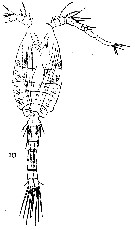 issued from : T. Mori in The Pelagic copepoda from the neighbouring waters of Japan, 1937 (1964). [Pl. 63, Fig.10]. As Oithona rigida. Male: 10, habitus (dorsal).
|
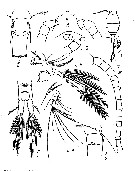 issued from : V.S. Shuvalov in Opred. Faune SSSR, Nauka, Leningrad, 1980, 125. [p.180, Fig.57]. As Oithona rigida aurea. After Lindberg, 1950. Female: 1, habitus (dorsal); 2-3, thoracic segment 5 and genital segment (dorsal and lateral, respectively); 4, anal segment and caudal rami (dorsal); 5-6, forehead (dorsal and lateral); 7, A1; 8, A2; 9, Md.
|
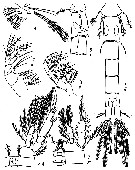 issued from : V.S. Shuvalov in Opred. Faune SSSR, Nauka, Leningrad, 1980, 125. [p.181, Fig.58]. As Oithona rigida aurea. After Lindberg, 1950. Female: 1, Mx1; 2, Mx2; 3, Mxp; 4, P4. Male: 5, urosome (dorsal); 6, thoracic segment 5, genital segment and urosomal segment 3; 7, P1.
|
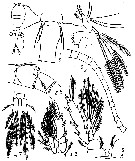 issued from : V.S. Shuvalov in Opred. Faune SSSR, Nauka, Leningrad, 1980, 125. [p.183, Fig.59]. As Oithona rigida elongata. After Lindberg, 1950. Female: 1, habitus (dorsal); 2, thoracic segment 5 and genital segment (ventral); 3, A1; 4, Md; 5, P4. Male: 6, thoracic segments 5 and 6 with P5 and P6 respectively; 7, P4; 8, caudal rami (dorsal).
|
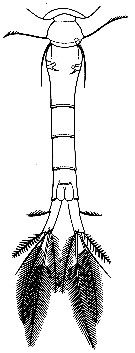 issued from : V.S. Shuvalov in Opred. Faune SSSR, Nauka, Leningrad, 1980, 125. [p.184, Fig.60]. As Oithona rigida elongata. After Lindberg, 1950. Female: urosome.
|
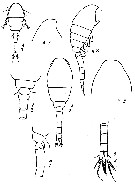 issued from : V.S. Shuvalov in Opred. Faune SSSR, Nauka, Leningrad, 1980, 125. [p.180, Fig.67]. As Oithona rigida . Female: 1-2, habitus (dorsal); ; 3, same (lateral); 4, forehead (lateral); 5, cephalon (dorsal); 6-7, thoracic segments 4 and 5, genital segment (dorsal and lateral); 8, posterior part of urosome (dorsal).
|
 Issued from K.-I. & D.-H. Lim in The Korean J. Syst. Zool., 1993, 9 (2). [Key of female]: ]Morphological characters of Oithona rigida (= Dioithona rigida) female in Korean waters :
1 - Anterior part of prosome rounded in dorsal view.
2 - Rostrum blunt. 3 - P5 with 2 setae. 4 - Length of exopod 3rd segment in legs P1-P4 longer than that of terminal spine of exopod 3rd segment.
|
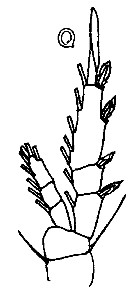 Issued from : K.-I. Yoo & D.-H. Lim in The Korean J. Syst. Zool., 1993, 9 (2) [p.99, Fig.2, Q]. As Oithona rigida (= Dioithona rigida). Female (from West Korean Waters): Q, P4.
| | | | | Compl. Ref.: | | | McKinnon & al., 2008 (p.843: Tab.1); Zakaria & al., 2016 (p.1, Table 1, Rem.) | | | | NZ: | 8 | | |
|
Distribution map of Dioithona rigida by geographical zones
|
| | | | | | | | | | | |  issued from : S. Nishida in Bull. Ocean Res. Inst., Univ. Tokyo, 1985, No.20. [p.144, Fig.96]. As Oithona rigida. issued from : S. Nishida in Bull. Ocean Res. Inst., Univ. Tokyo, 1985, No.20. [p.144, Fig.96]. As Oithona rigida.
Indo-Pacific geographical distribution of Dioithona rigida. |
 Issued from : P. Santhanam & P. Perumal in Indian J. Geo-Mar. Sc., 2012, 41 (4). [p.371, Fig.1]. As Oithona rigida. Issued from : P. Santhanam & P. Perumal in Indian J. Geo-Mar. Sc., 2012, 41 (4). [p.371, Fig.1]. As Oithona rigida.
Total mean production of O. rigida at maximum temperature and food concentration.
O. rigida collected from the Vellar estuary (SE coast of India) and rearing with mixed algae viz. Chlorella marina, Coscinodiscus centralis, Skeletonema costatum, Chaetoceros affinis in the concentration of 50,000 cells/mL.
Water quality parameters (temperatyre, salinity, pH, dissolved oxygen and the population density, growth and survival of nauplii, copepodite and adults were observed daily. |
 Issued from : P. Santhanam & P. Perumal in J. Mar. Biol. Ass. India, 2012, 54 (1). [p.40, Table 2]. Issued from : P. Santhanam & P. Perumal in J. Mar. Biol. Ass. India, 2012, 54 (1). [p.40, Table 2].
Effect of female body length on feeding rate (cells/animal) of Oithona (= Dioithona) rigida. |
 Issued from : P. Santhanam & P. Perumal in J. Mar. Biol. Ass. India, 2012, 54 (1). [p.41, Table 3]. Issued from : P. Santhanam & P. Perumal in J. Mar. Biol. Ass. India, 2012, 54 (1). [p.41, Table 3].
Effect of algal concentration on feeding rate (µg/l/h) of Oithona (= Diooithona) rigida. |
 Issued from : P. Santhanam & P. Perumal in J. Mar. Biol. Ass. India, 2012, 54 (1). [p.41, Table 4]. Issued from : P. Santhanam & P. Perumal in J. Mar. Biol. Ass. India, 2012, 54 (1). [p.41, Table 4].
Effect of algal type on feeding rate (µg/1/h) of Oithona (= Dioithona) rigida. |
 Issued from : P. Santhanam & P. Perumal in J. Mar. Biol. Ass. India, 2012, 54 (1). [p.42, Table 5]. Issued from : P. Santhanam & P. Perumal in J. Mar. Biol. Ass. India, 2012, 54 (1). [p.42, Table 5].
Effect of female body size on fecundity of Oithona (= Dioithona) rigida. |
 Issued from : P. Santhanam & P. Perumal in J. Mar. Biol. Ass. India, 2012, 54 (1). [p.42, Table 6]. Issued from : P. Santhanam & P. Perumal in J. Mar. Biol. Ass. India, 2012, 54 (1). [p.42, Table 6].
Effect of water temperature on fecundity of Oithona (= Dioithona) rigida. |
 Issued from : P. Santhanam & P. Perumal in J. Mar. Biol. Ass. India, 2012, 54 (1). [p.42, Table 7]. Issued from : P. Santhanam & P. Perumal in J. Mar. Biol. Ass. India, 2012, 54 (1). [p.42, Table 7].
Effect of algal feed concentration on fecundity of Oithona (= Dioithona) rigida. |
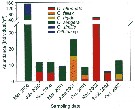 Issued from : J.-S. Hwang, R. Kumar, H.-U. Dahms, L.-C. Tseng & Q.-C. Chen in Zool. Studies, 49 (2). [p.224, Fig.3). Issued from : J.-S. Hwang, R. Kumar, H.-U. Dahms, L.-C. Tseng & Q.-C. Chen in Zool. Studies, 49 (2). [p.224, Fig.3).
Average abundances of six Oithona species recorded in the South China Sea from Mar. 2000 to Oct. 2002.
Sampling stations between 16-24° N, 114-120° E. O. rigida = Dioithona rigida by various authors. |
| | | | Loc: | | | South Africa (E), E Medit. (W Egyptian coast), Red Sea, Gulf of Oman, G. of Aden, Arabian Sea, Laccadive Is., Maldive Is., Sri Lanka, India (Vellar estuary, Porto Novo, Saurashtra coast, W, S, Lawson's Bay, Madras, Gulf of Mannar, Palk Bay, Rushikulya estuary), Indian, Nicobar Is. (Nankaurie Harbour), Straits of Malacca, Indonesia-Malaysia, Sarawak: Bintulu coast, Thailand, Viet-Nam, Hong Kong, China Seas (Yellow Sea, East China Sea, South China Sea, Pa-Li), T, N Yangtze Riv. estuary to Minjiang Riv.), Taiwan Strait, Taiwan (NW, Mienhua Canyon), S & W Korea, Japan, Kuchinoerabu Is., Tanabe Bay, W Baja California (Bahia Magdalena in Hernandez-Trujillo & al., 2010), La Paz, Gulf of California, Australia (Great Barrier, Melbourne, Shark Bay, North West Cape, G. of Carpentaria).
Type locality: Northern part of the Red Sea. | | | | N: | 80 | | | | Lg.: | | | (11) F: 0,83; (34) F: 0,86-0,7; (78) F: 0,8; (91) F: ± 0,76; M: ± 0,68; (109) F: 0,86-0,72; M: 0,67-0,62; (334) F: 0,85-0,75; M: 0,7; (349) F: 0,75; (349'*) F: 0,64-0,6; (530) F: 1; (531) F: 0,65; M: 0,5; (786) F: 0,9; (880) F: 0,75-0,83; 0,83-0,87; (1161) F: 0,72-0,84; M: 0,686-0,747; (1170) F: 0,68-0,84; {F: 0,60-1,00; M: 0,50-0,87} | | | | Rem.: | Characters female after Rosendorn (1917 a, p.39): Setal formula of the exopod swimming legs P1 to P4 (Se = outer setae ; Si = inner setae), P1 : 1, 1, 3 Se ; 1, 1, 5 Si ; P2 : 1, 1, 3 Se ; 1, 1, 5 Si ; P3 : 1, 1, 3 Se ; 1, 1, 5 Si ; P4 : 1, 1, 2 Se ; 1, 1, 5 Si . P5 with 2 setae.Dioithona rigida aurea Lindberg,1950 (F,M)
Syn.: Dioithona rigida aurea Lindberg, 1950 e (p.265, figs.F,M); Oithona (Dioithona) rigida aurea : Shuvalov, 1980 (p.179, figs.F,M)
Loc.: India (off Madras)
Lg.: (761) F: 0,912-0,789; M: 0,769-0,760; (880) F: 0,79-0,91; M: 0,76-0,77; {F: 0,79-0,91; M: 0,76-0,77}
Sewell (1947, p.256, as Oithona rigida female) notes: The proportional lengths of the anterior and posterior regions of the body as 45 to 45. The proportional lengths of the segments of the posterior region (Th 5 to caudal rami) as 12:29:16:16:13:14 = 100. Caudal rami 2.33 times as long as broad; the outer seta is delicate and is shorter than the ramus, it arises slightly on the proximal side of the middle of the ramus; the 2nd caudal seta is the longest , and is equal in length to abdominal segments 3-5 plus the caudal ramus. A1 12-segmented (segments 3- 4 and 13 -14 respectively almost completely fused, and 5-6 partially fused); there is a short spinous prominence on the distal margin of the 5th segment (the 4th segment if segments 3-4 are counted as one). In the swimming legs the terminal spine of the 3rd exopodal segment is very considerably shorter than the ramus itself and, except in P1, it is shorter than the 3rd exopodal segment. In P1 the exopod bears 1, 1, 3 outer spines and 1, 1, 4 inner setae; the endopod bears 1, 1, 5 inner setae and 0, 0, 1 outer setae. Rosendorn (1917, p.39) gives the number of inner setae on the 3rd exopodal segment as 1, 1, 5, this is incorrect. In P2 and P3 the exopod bears 1, 1, 3 outer spines and 1, 1, 5 inner setae; the endopod bears 1, 2,5 inner setae and 0, 0, 1 outer setae. P4 bears on the exopod 1, 1, 2 outer spines and 1, 1, 5 inner setae; the endopod bears 1, 2, 4 inner setae and 0, 0, 1 outer setae.
For Farran (1913 a, p.189) this species is closely allied to D. oculata, but can be distinguished (see Nota in Farran's plate XXXI Farran, 1913a, p.189).
See in Oithona robertsoni Table 2 from McKinnon (2000, p.108).
After McKInnon (2000, p.112) Oithona rigida is referred to the genus Dioithona Kiefer, 1935 on the basis of having 2 setae on the free segment of P5. Despite by Vervoort (1964), the generic rank of Dioithona has bcome widely used in recent litterature, species present in North Queensland coastal waters.
| | | Last update : 04/12/2020 | |
|
|
 Any use of this site for a publication will be mentioned with the following reference : Any use of this site for a publication will be mentioned with the following reference :
Razouls C., Desreumaux N., Kouwenberg J. and de Bovée F., 2005-2025. - Biodiversity of Marine Planktonic Copepods (morphology, geographical distribution and biological data). Sorbonne University, CNRS. Available at http://copepodes.obs-banyuls.fr/en [Accessed January 03, 2026] © copyright 2005-2025 Sorbonne University, CNRS
|
|
 |
 |

















